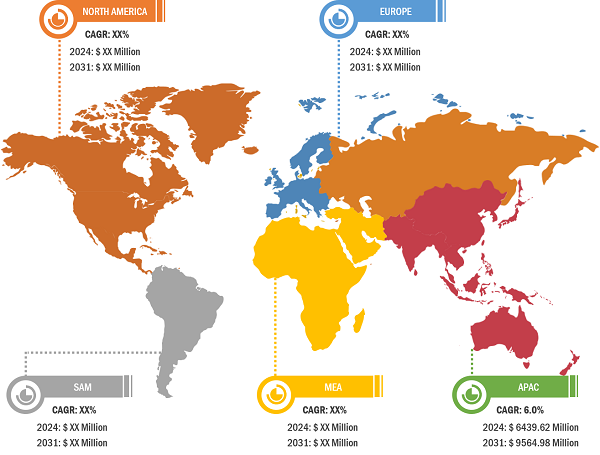Global Residential Rainscreen Cladding Market Forecast to 2031: Key Insights
According to our latest study on "Global Residential Rainscreen Cladding Market – Global and Regional Share, Trend, and Growth Opportunity Analysis – by Cladding Material, Construction Type, and Geography," the market was valued at US$ 6439.62 million in 2024 and is expected to reach US$ 9564.98 million by 2031. The global residential rainscreen cladding market size is estimated to register a CAGR of 6.0% during 2025–2031.
Installing a layer of water-resistant material on buildings helps to stop the moisture from getting in, thereby improving energy efficiency and visual appeal. This method is known as residential rainscreen cladding. It usually consists of two layers and lets moisture escape the building through a ventilated air gap. Common materials for this type of cladding include fiber cement, high-pressure laminate, terracotta, natural stone, composites, and metals such as copper, stainless steel, and aluminum. Residential rainscreen cladding can create stylish, modern designs, durability, low maintenance, thermal insulation, and better moisture control. Rainscreen cladding is often found in residential buildings, including single-family homes and multi-family apartment complexes. Its lightweight and effective design requires fewer parts than larger commercial buildings.
Residential Rainscreen Cladding Market
Residential Rainscreen Cladding Market Size and Forecast (2021 - 2031), Global and Regional Share, Trend, and Growth Opportunity Analysis Report Coverage: By Cladding Material (Ceramic, Timber, Composite Materials, Metals, and Others), Construction Type (New Construction and Renovation), and Geography (North America, Europe, Asia Pacific, Middle East and Africa, and South America)
Residential Rainscreen Cladding Market Size & Share by 2031
Download Free Sample
The residential rainscreen cladding market growth is due to more construction activities and a rising demand for energy-efficient, sustainable homes that offer better moisture protection. Major factors propelling the market demand include stricter government building codes focusing on energy savings and sustainability, increased urbanization, and new developments in lightweight, fire-resistant, and recyclable materials. Likewise, various market prospects arise with the rise of prefabricated and ventilated façade solutions, which reduce installation time and lifecycle costs while allowing for high customization. However, there are challenges. The initial cost of rainscreen cladding systems is higher compared to traditional cladding. Furthermore, logistical issues have been a significant growth with the prospect of raw materials and skilled labor. Furthermore, a shift toward green building standards and global net-zero carbon goals is one of the residential rainscreen cladding market trends.
The market for residential rainscreen cladding is growing rapidly in North America. Government policies and programs promote energy-efficient building methods. Nations such as the US, Canada, and Mexico enforce strict sustainability regulations. This includes rules from the National Building Code of Canada and the US Environmental Protection Agency.
There is a strong renovation industry in this area. Rainscreen cladding is becoming a popular retrofit choice for older buildings among developers and homeowners who want to improve insulation and reduce energy loss. There is more demand for fire safety and modern designs, especially after recent tragedies in the US. This situation has led to a rise in the use of environmentally friendly cladding systems. In terms of developing and applying rainscreen cladding in homes, this trend propels the market in North America.
The European region holds a noteworthy position in the global rainscreen cladding market owing to strong regulations and high demand for sustainable construction. Various nations, such as Germany, the UK, France, and Italy, are way ahead in using rainscreen cladding for new homes and social infrastructure projects. Growth in building activity, coupled with increasing immigration and urban renewal efforts, helps to propel the need for a modern cladding system. Moreover, the nations mentioned above implement strict building codes that promote energy efficiency and quickly embrace new materials for style and strength. EU-wide sustainability goals encourage the use of recyclable, low-maintenance cladding materials, as governments promote green building projects and support low-carbon housing initiatives. This leads to continued investment from both the public and private sectors, which boosts the use of residential rainscreen cladding throughout Europe.
Global Residential Rainscreen Cladding Market Share: Segmental Overview
The new construction segment accounted for largest global residential rainscreen cladding market share as it is included in modern construction projects from the beginning. This segment takes advantage of the benefits of rainscreen cladding systems, such as durability, waterproofing, and design flexibility. These features can be easily integrated into buildings during the initial construction phase without disrupting other structures. Compared to renovation, new construction enables better design and installation processes that maximize efficiency and performance while lowering labor complexity and costs.
Rainscreen cladding in new residential buildings, which range from single-family homes to multi-family apartment complexes, improves the building’s ability to resist moisture and significantly boosts thermal insulation. This combined benefit meets tougher building codes and rising demands from consumers and regulators for energy-efficient and sustainable homes. Architects and developers are attracted to rainscreen cladding systems in new construction because of their design flexibility, which supports innovative façade styles.
The new construction residential rainscreen cladding market growth aries from the overall recovery and expansion of the global construction industry. New residential projects increasingly use rainscreen cladding to meet sustainability targets and enhance durability. As environmental concerns and energy standards tighten, new construction will continue to drive the global residential rainscreen cladding market toward strong growth in the coming years.
Global Residential Rainscreen Cladding Market Analysis: Competitive Landscape and Key Developments
The global residential rainscreen cladding market report emphasizes the key factors driving the market and the prominent players' developments. Merson Group, Trespa International B.V., Carea Ltd, Kingspan Holdings (Ireland) Limited, ROCKWOOL A/S, Soprema Insulation Limited, Fundermax North America Inc., Knauf Digital GmbH, and James Hardie Building Products Inc. are among the prominent players profiled in the global residential rainscreen cladding market report. The market players focus on new product launches, expansion and diversification, and acquisition strategies, which allow them to access prevailing business opportunities.
Contact Us
Phone: +1-646-491-9876
Email Id: sales@theinsightpartners.com